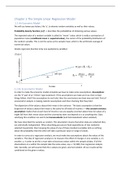Summary
Summary Principles of Econometrics (& Using Stata), ISBN: 9781119510567 Intermedia Statistics II for Economists
- Course
- Institution
- Book
Includes all relevant chapters for the course Principles of Econometrics, including some key Stata tips from the book "Using Stata for Principles of Econometrics". Book: Principles of Econometrics.
[Show more]





